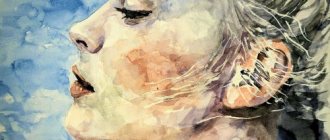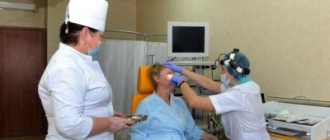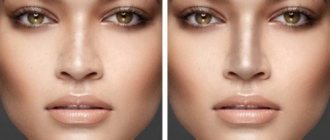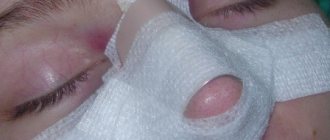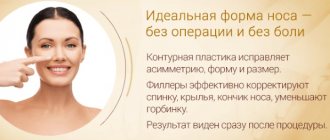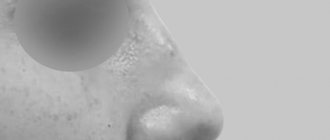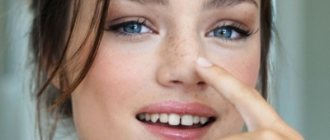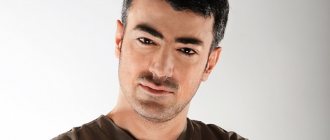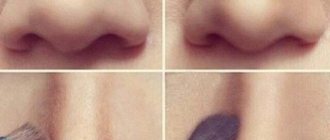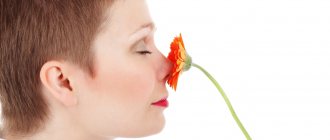Every fifth woman is unhappy with her nose. Rhinoplasty is considered the second most popular plastic surgery. Moreover, this is one of the “youngest” interventions. Most often, young girls turn to plastic surgeons. They strive to correct the length and shape of the nose, remove a hump, or restore impaired nasal breathing. In most cases, there is no alternative to surgical plastic surgery. Patients always come with exact confidence in the need for surgical intervention. The method of performing the manipulation is determined by the surgeon. There are open and closed rhinoplasty. Let's figure out how these methods of nose correction differ.
What is the difference between closed rhinoplasty and open rhinoplasty?
Plastic surgery of the nose is performed in two main directions:
- with external access - exposure of cartilage using an external incision;
- with endonasal access - incisions from the inside of the mucous membranes.
During open plastic surgery, an incision is made on the thin septum in the internostril space - the columella, as well as along the surface of the nostrils (sometimes at the base of the nasal passages).
In closed rhinoplasty, incisions are made from the inside of each nostril. The columella and skin are not affected. There is no likelihood of scar formation, which is why this method is considered by patients themselves as the most optimal.
Buyanov Sergey Yurievich (Expert Doctor):
The closed rhinoplasty method is used only in cases where there is no need to install implants and correct bone tissue (filing down the nasal hump). With a closed technique, such manipulations cannot be done blindly.
How is the operation performed?
Closed rhinoplasty includes several stages:
- Skin incisions .
On both sides, marks are applied to the skin of the nasal vestibule, which correspond to the projection of the tip, for more precise application of the incision. The incision line should be at least 6 mm from the caudal portion of the lateral crus of the greater cartilage to provide adequate support. Then, tweezers and blunt scissors are used to secure the skin over the tip of the nose. Part of the lateral crus is removed. With a drooping tip of the nose and a “hanging” columella, the incision is continued into the transfection one (between the head section of the medial crus of the lateral cartilages and the caudal section of the quadrangular cartilage). To raise the upper lip, the spine of the upper jaw is removed. - Reducing the length of the nasal septum.
- Exposure of the nasal bridge and removal of the osteochondral hump . With closed rhinoplasty, the osteochondral hump is removed by reducing the height of the nasal bridge. Before resection of the hump, the mucous membrane is mobilized. Then the upper lateral cartilage is partially removed, and if necessary, a lateral osteotomy is performed, which is the next step.
- Lateral dissection of the patient's nasal bone.
- Formation of the tip and wings of the nose .
Reducing the size of the tip of the nose is done by weakening the supporting structures. The supporting structures of the nose are scored. If the incisions are applied far from each other, then the nostrils will appear wide and then it is necessary to suture the medial legs of the upper lateral cartilages or use an autograft. The use of an autograft allows you to increase the size of the tip of the nose and ensure its rotation. - Placement of mattress sutures on the incisions.
- Bandage . Applying a plaster bandage on top of which is a gauze bandage. Intravenous dexamethasone to reduce swelling. According to indications, nasal tamponade is performed.
Duration
Closed rhinoplasty lasts from 30 to 60 minutes.
Description of the closed method
Closed rhinoplasty involves the use of endosanal access - all incisions are made inside the nose.
The procedure is aimed at correcting or eliminating various shortcomings and defective conditions. It is considered one of the most innovative techniques that allows effective surgical intervention.
Special incisions are made in the nasal cavity, with the help of which it becomes possible to separate the skin from the cartilage and bone tissue. As a result, it is easy to correct and restore shape.
Efficiency
The closed type of rhinoplasty of the nose is a more gentle procedure. In this case, the technique is indicated for easy correction.
It allows you to get rid of:
- congenital nasal defects;
- deviated septum;
- damage after injury;
- excessively large or small nostrils;
- breathing problems or lack of normal respiratory function;
- deviations in shape, for example, a long or thick nose, snub nose.
Possible difficulties
Despite its high efficiency, the closed technique provides a poorer overview of the surgical field.
Doctors may have difficulty examining anatomical structures. Some of them are not clearly visible, while others may not be visible at all.
In some cases, the surgeon has to work “by touch.”
Poor visualization prompts additional manipulation of the soft alar cartilages. For example, making a cut or displacement. This can provoke a risk of deformation, which negatively affects the shape of the tip of the nose in the period after surgery.
If there is a need to correct an aesthetic defect in the vaults or arch of the wing cartilages, it will not be possible to achieve complete symmetry.
results
The primary results of the operation can be seen in 10-14 days.
However, the final result will be available to the patient only after 8-10 months, when all the flaws have gone away and the tissues will be normally located on the new nose. It often happens that relatives and friends do not see any changes in appearance after surgery, since hematomas and swelling muffle the main result. In such a situation, the patient should not immediately be sent for a second operation, but must wait until the moment when the face returns to its normal state and then evaluate the final result.
Also, it should be noted that rhinoplasty will not have a genetic effect and is not passed on to descendants, as certain patients believe. This operation improves only the appearance of a person.
Anyway. Only the patient, having learned all the pros and cons of the upcoming operation, needs to decide whether to undergo the operation.
A very important point: you should select a clinic only that employs highly qualified specialists who have extensive experience behind them and a minimum number of punctures in performing operations. If the reviews about the clinic and the doctor are good, then it is possible to go to a specialist for a consultation and understand for yourself whether rhinoplasty is necessary at all.
Main indications for use
The procedure is prescribed to eliminate congenital or acquired nasal disorders. The patient can get rid of difficulties in nasal breathing and adjust the aesthetic parameters of appearance.
Rhinoplasty is allowed after 25 years.
If there is an urgent need for surgery, age restrictions are usually lifted.
Medical indications:
- diagnosing hypertrophy and polyps;
- violations of the structure of the septum;
- breathing problems;
- nose damage.
Breathing problems, especially in children, can lead to constant oxygen deprivation in the brain area. This disorder is often the cause of mental and physical retardation and mental disorders.
Rhinoplasty is also used when the shape or size of the nose does not correspond to the patient’s wishes. Some people want to correct the position of the tip of the nose (for example, with a snub nose).
Aesthetic problems can lead to complexes, and this, in turn, affects personal and professional success. To prevent the formation of feelings of inferiority, doctors may prescribe plastic surgery.
Advantages of surgery at the GALAXY Beauty Institute
The constant development of closed rhinoplasty technology makes it possible to perform any type of nose shape correction. Doctors at the GALAXY Beauty Institute use unique proprietary techniques and original developments. They regularly improve and hone their skills. Thousands of successful operations and satisfied patients speak for themselves. Closed access has many advantages.
- There are no scars after the operation - the nose looks completely natural.
- The tip of the nose does not sag over time, since the supporting function of the collumella is preserved.
- During manipulations, the surgeon sees the result of his work, since the skin remains in place.
- The blood supply to the tip is preserved in full, since the collumella arteries do not intersect.
- The operation is performed using the most gentle method possible, since the skin is not cut and is not lifted above the structures of the nose.
- Fast rehabilitation. A little more than a week for recovery - and you can evaluate the first result. Within a month, the patient returns to his usual lifestyle, and within 6-8 months the final result is assessed.
Every patient of the GALAXY Beauty Institute deserves the best. The vast experience of surgeons, a lot of proprietary developments and modern equipment of operating rooms make it possible to cope with the most complex tasks, including revision rhinoplasty.
List of contraindications
The procedure may have some limitations, so you must undergo examinations before it is performed.
Rhinoplasty is not performed if:
- mental disorders and diseases caused by this factor;
- inadequately formed patient requests;
- addiction to drug use;
- nose correction, which caused deformation of soft tissues;
- presence of heart and liver diseases;
- oncology;
- poor blood clotting;
- infectious pathologies, congenital defects.
Experts recommend excluding the procedure until the age of 17-18, which is determined by the structure of the cartilage and bone tissue of the nose.
Prices in Moscow and St. Petersburg
In Moscow
| Nose section | Cost in rubles |
| Septoplasty (plasty of the nasal septum). | 45-140 thousand |
| Tip of the nose. | 80-150 thousand |
| Wings of the nose. | 45-80 thousand |
| Complete nose correction. | 180-300 thousand |
In St. Petersburg
| Nose section | Cost in rubles |
| Septoplasty (plasty of the nasal septum). | 40-80 thousand |
| Tip of the nose. | 50-120 thousand |
| Wings of the nose. | 40-80 thousand |
| Complete nose correction. | 95-200 thousand |
From our separate publications you can find out what stages rhinoplasty consists of, as well as:
- How to avoid an unsuccessful operation and what to do if it does occur?
- What are the pros and cons of thread rhinoplasty?
- What are the techniques for performing plastic surgery on the wings, tip and other parts of the nose?
Carrying out plastic surgery
Preparation
To exclude complications and determine the possibility of applying correction, it is necessary to undergo a comprehensive analysis. A computed tomography scan of the nasal cavity is also prescribed.
If there are no contraindications, then the doctor decides to carry out the procedure.
How it goes
The manipulation is carried out without opening the nose. To do this, two incisions are made. This is how you can separate the skin from the cartilage and bone tissue.
The internal turundas will be removed on the second day after rhinoplasty is completed. If rhinoseptoplasty was performed, then the turundas are removed for 3-4 days.
Sometimes silicone splints are left for a longer period, but nasal breathing is maintained.
Complications
Like any surgery, closed rhinoplasty can have side effects and complications. The presence and degree of their severity depend both on the patient himself and on the qualifications of the doctor.
Complications and side effects:
- Hypoxia.
- Hyperthermia.
- Bleeding.
- Tears in the skin of the columella.
- Damage to the tear duct.
- Allergic reaction.
- Hematomas.
- Tearing.
- Severe swelling.
- Seams coming apart.
- Uncontrollable sneezing, headaches, aspiration with intranasal tampons, toxic shock, exacerbation of chronic sinusitis (as an inflammatory reaction to prolonged use of tampons).
- Pigmentation.
- Skin pustules as a result of improper application of plaster casts.
- Dacryocystitis is inflammation of the lacrimal duct.
- Soft tissue necrosis is rare.
- “Open roof” syndrome occurs as a result of overcorrection of the osteochondral hump.
The risk of complications and side effects can be reduced to a minimum by following the principles:
- Careful selection of patients, having studied their anamnesis, anatomical features and tests.
- Use of hypotensive anesthesia.
- Detailed planning of the course of the operation, as well as the correct choice of surgical technique.
- Careful packing.
- Correct selection of tools.
- Use of broad-spectrum antibiotics.
We invite you to watch a video about the occurrence of complications after rhinoplasty:
You will find information about the consequences and possible complications after rhinoplasty, as well as photos before and after the procedure, here.
Healing period
To fix the structure and prevent mechanical impact, a plaster splint or a plastic type retainer is applied to the nose.
This design will have to be worn at home, since discharge from the hospital occurs after 2-4 days, and the splint is removed after 1-2 weeks.
- During the first few days, the patient remains in the clinic with a cast applied for proper healing and recovery.
- After some time, it can be replaced with a bandage with the removal of cotton swabs.
- It is allowed to take a warm shower or a warm bath, eliminating the risk of the bandage getting wet.
Taking the necessary tests and preparing for surgery
- Valid for 10 days : general blood test, general urine test, biochemical blood test, coagulogram.
- Valid for 1 month : blood test for HIV, RW, hepatitis B and C, ECG.
- done no later than 12 months .
- Indefinitely - belonging to the blood group and Rh factor; X-ray of the paranasal sinuses.
Before the operation you must:
- 2 weeks before surgery, stop smoking and drinking alcohol, as well as medications (hormonal contraceptives, anticoagulants), spicy, salty, smoked foods.
- Do not eat or drink a couple of hours before surgery.
Precautionary measures
After surgery, it is important to avoid stress and excessive physical activity, as such shocks can increase blood pressure.
Although traces of the intervention will not be visible, the need for anti-inflammatory therapy may be present. To prevent bleeding, it is advisable to replace glasses with lenses.
In the first days you can only drink in very small sips, no more than 2 liters per day. Hot and cold foods are temporarily excluded from the menu, and spicy foods and spices are not consumed.
Buyanov Sergey Yurievich (Expert Doctor):
It is necessary to avoid hypothermia, therefore, a runny nose. The development of inflammatory rhinitis will aggravate the swelling of the nasal mucosa and complicate or even block nasal breathing. For the same reason, it is not recommended to perform surgery on people prone to seasonal allergies during exacerbations.
Cosmetic procedures, such as peeling, are also prohibited. You should not use decorative cosmetics.
Rehabilitation
Strict adherence to doctor's instructions:
- Elevation of the head end of the bed during sleep.
- Applying a cold compress for 2 days.
- Do not take alcohol, aspirin, or medications containing salicylates for 2-2.5 weeks.
- Liquid food on the first day.
- Limiting physical activity for 3 months.
- Do not blow your nose or wear glasses for 1 month.
- Avoid direct sunlight and use SPF 20 sunscreen.
- Refrain from hot baths for the first 2 days.
The duration of rehabilitation activities is from 1 to 6 months.
Find more information about rehabilitation after rhinoplasty here.
Photos before and after
Rhinoplasty and rhinoseptoplasty: what is the difference?
Let's start with an important fact that, like a red thread, runs through the entire medical practice of plastic surgeons - patients with perfectly straight nasal septums are in the absolute minority. Such people, as well as those with an impeccable bite, are extremely rare. Therefore, often when a patient wants to undergo rhinoplasty, during an examination and CT (computed tomography) scan of the sinuses it turns out that he also needs correction of the nasal septum.
Konstantin Aleksandrovich Matveev - Candidate of Medical Sciences, maxillofacial surgeon, plastic surgeon at the Pirogov Clinic
Opinion of cosmetologists
To understand whether closed rhinoplasty is safe and effective, just read the reviews of specialists.
Reviews
Anton : “After an accident 6 years ago, I was left with a crooked nose. It looked bad and it was difficult to breathe. Six months ago I had closed rhinoplasty. I felt like a different person!”
Lydia : “My nose has not suited me since childhood - its curvature was striking and spoiled my face, so it was not difficult to decide on surgery. At the consultation, the doctor advised me to have closed rhinoplasty. I saved up some money and went to the clinic. The result is amazing! I’m very pleased.”
Daria : “I was diagnosed with a deviated nasal septum and was told that I would have to have surgery. Outwardly it is not noticeable, but I was plagued by frequent allergies and a chronic runny nose. My plastic surgery was performed by a first-class surgeon with a good reputation, which inspired confidence in the positive outcome of this important procedure. When the plaster was removed, terrible bruises and swelling were discovered that lasted about ten days. But now I’ve forgotten what a runny nose is.”
